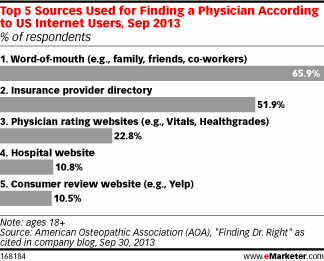Physician Marketing and the Power of Word-of-Mouth
 [Series Installment] There’s a line of thinking quietly at work among a few healthcare practices that says: “Simply being a good doctor will guarantee success.” A few satisfied patients will fuel “word-of- mouth,” and that’s all you need in business.
[Series Installment] There’s a line of thinking quietly at work among a few healthcare practices that says: “Simply being a good doctor will guarantee success.” A few satisfied patients will fuel “word-of- mouth,” and that’s all you need in business.
There’s a lot of appeal to the idea of attracting new patients with near-no-cost marketing based on patient satisfaction. While reputation and satisfaction are vital ingredients, “spreading the word” does not occur spontaneously.
Word-of-Mouth (WOM) is a powerful concept where social influence—opinions, behaviors, emotions—affect the purchase decisions of others. Social proof is the phenomenon that causes people to follow the actions of others, which are seen as the “correct behavior for a given situation.”
As competition in healthcare has escalated, and the Internet has become pervasive, the peer-to-peer WOM delivery system has expanded to include social media—Facebook, Twitter and many others. Worldwide, WOM recommendations of friends and family members, a Nielson survey reports, are the most trusted and influential source of information.
But for nearly three-quarters of survey respondents, online reviews of other consumers are also a trusted, and influential, resource. The reach, frequency and timeliness of a one-to-one endorsement is multiplied and magnified by the Internet.
Another survey—by the American Osteopathic Association and reported by eMarketer.com— echos the value of family, friends and co-workers in finding a physician.

Inspiring positive word-of-mouth…
The baseline assumption for every healthcare provider is that they provide people with exceptional care and a positive patient experience…every time, every day. Although that may be sufficient fuel for some patients, here are several useful suggestions that help inspire word-of-mouth in physician marketing.
Teamwork. Everyone in the office is responsible for what the patient experiences during the visit. The physician and the practice are in the spotlight, but influence occurs at each of the customer touch points, from pre-appointment though follow-up. Every member of the team is vital to success.
Relationship First. People like doing business with people they like. When patients/consumers feel a personal connection with a provider and practice, they are likely to refer and are open to positive word-of-mouth. The first order of business is to engender a person-to-person relationship with each patient.
Identify Influencers. Some individuals tend to self-identify as positive voices about their experience. Be aware of the enthusiasm and support of your most likely champions. You’ll meet them in person, and they are the thought leaders that emerge in your social media connections.
Give Everyone Your Shareable Story. Word-of-Mouth is a slice of conversation. Providing everyone with an interesting and relevant story or pearl of wisdom is verbal ammunition that will be remembered and retold.
You Have to Ask. Even those individuals who are “positively inclined” to refer others need to know that that their recommendations and comments are important and welcome. Encourage them to do so, reference how others have done this, and provide “how-to” directions if needed.
Endorsements—patient-to-patient, online reviews, and other methods of word-of-mouth—are highly effective marketing tools for medical practices, hospitals and individual providers. Online reviews are trusted nearly as much as personal recommendations. Word-of-mouth, in person or online, increase visibility, and enhance professional reputation.
THIS SERIES CONTINUES -- You’ll find additional reading here:
How to Trigger Word of Mouth Advertising and Physician Practice Referrals
From Prospect to Patient to Referral: The Healthcare Decision Journey
Kathy Gaughran








